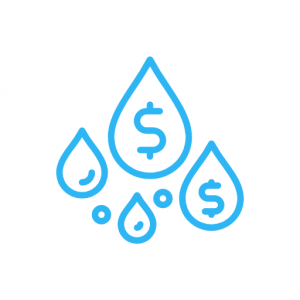What is a revenueshed?
A revenueshed is the geographic area within which revenue is generated for a defined purpose. It’s a play on words of watershed, an area that drains all water to a common outlet. The purpose of the revenueshed is to model methods of revenue generation for a designated funding goal using new and existing mechanisms. The revenueshed also expands those who pay beyond the traditional polluter pays model by incorporating additional beneficiaries into the model. For example, rather than using solely the boundary of a watershed to source funding for a water quality project, a wider boundary could be drawn to include local governments holding drinking water allocations for the specified water body[1].
Why is it important to contemplate new ways to draw boundaries to gather revenue for watershed protection?
Modification of existing revenue generation boundaries from the polluter pays model to the revenueshed model allows decision makers to identify the local or individual actions necessary to generate a revenue for watershed protection and creates buy-in for jurisdictions that do not have drinking water allocation, by including jurisdictions that do.
The revenueshed framework can be used for a variety of objectives, including: (1) cultivating accountability for all those that contribute to a problem and benefit from a solution, (2) promoting discussions and collaborations among local governments, and (3) developing interactive financial tools to assist in policy-making [2]
What tools does the EFC have for modeling the revenueshed concept?
Over the past decade, the EFC has created various tools to represent the revenueshed approach to environmental finance. Most recently, we applied the revenueshed concept to the Jordan Lake watershed as a part of a North Carolina Legislature commissioned Jordan Lake Nutrient Management Study[3]. For this research, the EFC calculated potential scenarios based on manipulating several revenue generation structures in the watershed, including property taxes, water and wastewater rates, and stormwater fees. The former are all existing mechanisms available to local governments for water quality improvement, while the latter is only currently applicable to jurisdictions with a stormwater utility.
Due to its compelling and interactive data visualization techniques, the EFC has decided to explore modeling revenuesheds via the data visualization platform Tableau. We are presently working on the prototype, using the Jordan Lake Watershed as a proof of concept. The new tool identifies two basic revenuesheds: the water quality revenueshed and water supply revenueshed which were identified in the EFC report for the Jordan Lake Nutrient Study (see Figure 1).
The watershed quality revenueshed consists of all tax parcels and environmental service rate payers within the Jordan Lake Watershed, defined as the Haw HUC8 watershed taken from the National Watershed Boundary Database published by the USGS.
The water supply revenueshed is made up of eight municipalities, three counties, and one water authority that have access now to Jordan Lake water or could in the future have access based on Jordan Lake allocations and current planning initiatives. All entities but two, Hillsborough and Holly Springs, have some or all of their territory also located in the watershed drainage basin revenueshed.

Edit: Wake County no longer has drinking water allocation. Figure 1.
Interacting with the tool, the user can select a project amount and choose to source funding through a loan, cash, or a combination of both. The user can then investigate the various sources of revenue available to reach the identified project goal, including changes in water rates, wastewater rates, stormwater rates, property tax and sales tax, and view how revenue generation differs between the water quality and water supply revenuesheds (see Figure 2).
Once the tool is completed on the Tableau application, the process can be adapted to other watersheds, opening doors for the EFC to define revenuesheds in other regions. Revenuesheds continue to facilitate discussion amongst watershed stakeholders, and the revenueshed tool allows interactive decision making, and analysis of creative financing solutions.

Figure 2

Figure 3
[1] Erin Riggs, Financing Nutrient Management in North Carolina. The Environmental Finance Center. 2018.
[2] Erin Weeks, Applying the Revenueshed Concept: Watershed Protection in a North Carolina River Basin. The Environmental Finance Center. 2012.
[3] Erin Riggs, Evan Kirk, and Jeff Hughes. Paying for Nutrient Reduction and Management in Jordan Lake. The Environmental Finance Center. 2019.
Cassidy Harding joined the EFC in 2020 as a research assistant on the EPA Exchange Network project. She is a first year in the Master of Information Science program at the School of Information and Library Science. Cassidy graduated from the University of North Carolina at Chapel Hill in 2019 with a B.S. in Environmental Science.





Leave a Reply